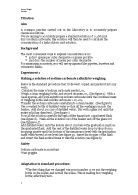titration - I am to be given a sample of sulphuric acid thought to have a concentration between 0.05 and 0.15 mol dm- and have to find out the accurate concentration of the acid.
Finding out how much acid there is in a solution
By Mohammed Babor Quibria Hossain
CS 6A5
- PLAN
- Aim
I am to be given a sample of sulphuric acid thought to have a concentration between 0.05 and 0.15 mol dm-³ and have to find out the accurate concentration of the acid. I am also provided with solid, anhydrous sodium carbonate, a range of indicators and details about the suitability of the indicators for different types of titration.
- List of Apparatus
- Burette.
- Sulphuric acid (250cm³).
- Anhydrous sodium carbonate
- 250cm³ volumetric flask.
- Clamp stand.
- 250cm³ conical flask.
- 25cm³ pipette.
- Pipette filler.
- Weighing boat.
- Weighing scale.
- Spatula.
- Filter funnel.
- Wash bottle and distilled water.
- Methyl Orange indicator solution.
- Risk Assessment
During my investigation there are key hazards that I have to look out for. They are listed in the table below:
- Method
- I need to calculate the mass of sodium carbonate I will need in order to make up a standard solution.
- Calculation to find the mass of sodium carbonate:
I have chosen to use a 0.1moldm-3 solution of sodium carbonate, this is because it is in the middle of the range for the concentration given in the aim. I have chosen to use 250cm3 of sodium carbonate because it is an easy to handle quantity, it allows me to do many titrations without wasting too much which isn't used. To make a solution of this concentration I will have to dissolve an amount of sodium carbonate in a fixed amount of water here is my calculation for this:
Find the relative molecular mass (Mr) of sodium carbonate by adding the relative atomic mass (Ar) of everything that makes up sodium carbonate (Na2CO3) together.
Na, Ar = 23 C, Ar = 12 O, Ar = 16
23 + 23 + 12 + 16 + 16 + 16 = 106 Mr = 106
The mass of 1 mole of Na2CO3 is 106g
If 106g of Na2CO3 was added to 1dm3 of water this would produce a 1moldm-3 solution. I want 250cm3 of 0.1moldm-3 solution to find this I will apply the formula:
Concentration = number of moles
Volume we need to find the number of moles so by multiplying concentration by volume to give number of moles
To do this calculation the volume must be converted into dm3 from cm3 this is done by dividing the volume by 1000.
250 = 0.25dm3
1000
Concentration x volume = moles
0.1moldm-3 x 0.25dm3 = 0.025 moles
Multiplying the number of moles required by the mass of 1 mole gives the mass required to make the solution.
106 x 0.025 = 2.65g of Na2CO3 required to make 250cm3 of 0.1moldm-3 solution. So I will dissolve 2.65g of sodium carbonate in 250cm3 of distilled water to make 250cm3 of 0.1moldm-3 sodium carbonate solution.







